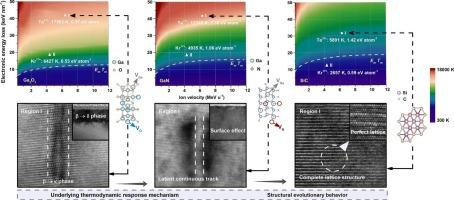Distinctive features of structural evolution and thermodynamic response in wide-bandgap semiconductors driven by intense electronic excitation
IF 6.9
2区 材料科学
Q2 CHEMISTRY, PHYSICAL
引用次数: 0
Abstract
Radiation-tolerant material selection requires balancing lattice rigidity, defect dynamics, and electronic stability, as shown by covalent SiC outperforming ionic Ga2O3 and GaN under extreme environments. Responding to intense electronic excitation, irradiation-driven phase segregation (β → δ/κ in Ga2O3) and core–shell track (disordered structure in GaN), accompanied by elemental redistribution, contrastingly, exceptional radiation tolerance manifested by comparatively minimal lattice distortion (0.17 % strain variation) was demonstrated in SiC. These differential responses are primarily attributed to two fundamental mechanisms: (i) thermodynamic driving forces governing defect migration and phase separation, and (ii) the synergistic effects of robust covalent bonding composition coupled with efficient defect recombination processes. The stronger electron–phonon (e-ph) coupling in Ga2O3 (4.34 × 1018 W m−3 K−1) and GaN (3.55 × 1018 W m−3 K−1) enhances lattice energy deposition, triggering thermal spikes (ΔT ≫ Tm) and structural transition behaviors, whereas weaker e-ph coupling in SiC (3.69 × 1018 W m−3 K−1), relatively high thermodynamic parameters and efficient energy dissipation suppress thermal spikes to maintaining lattice integrity. The photoresponse degradation driven by enhanced radiative recombination is dominant in N-doped SiC, while V-doped systems achieve defect-mediated photoconduction optimization characterized by abrupt current transitions, matching fluorescence yield evolutions, and directly connecting defect engineering to optoelectronic performance.

强电子激发下宽禁带半导体结构演化和热力学响应的独特特征
耐辐射材料的选择需要平衡晶格刚度、缺陷动力学和电子稳定性,正如共价SiC在极端环境下优于离子Ga2O3和GaN所示。在强烈的电子激发下,辐照驱动的相偏析(Ga2O3中的β → δ/κ)和核壳径迹(GaN中的无序结构)伴随着元素重分布,相比之下,SiC表现出优异的辐射耐受性,晶格畸变相对较小(应变变化0.17 %)。这些差异反应主要归因于两个基本机制:(i)控制缺陷迁移和相分离的热力学驱动力,以及(ii)强大的共价键组成与有效的缺陷重组过程的协同效应。较强的电子声子(e-ph)耦合Ga2O3(4.34 × 1018 W −3 K−1)和氮化镓(3.55 × 1018 W −3 K−1)提高晶格能量沉积,引发热峰值(ΔT≫Tm)和结构转变行为,而弱e-ph耦合在SiC(3.69 × 1018 W −3 K−1),相对较高的热力学参数和有效的能量耗散抑制热峰值保持晶格的完整性。在n掺杂SiC中,由增强的辐射复合驱动的光响应退化是主要的,而v掺杂体系实现了缺陷介导的光导优化,其特征是电流突变,匹配荧光产额演变,并直接将缺陷工程与光电性能联系起来。
本文章由计算机程序翻译,如有差异,请以英文原文为准。
求助全文
约1分钟内获得全文
求助全文
来源期刊

Applied Surface Science
工程技术-材料科学:膜
CiteScore
12.50
自引率
7.50%
发文量
3393
审稿时长
67 days
期刊介绍:
Applied Surface Science covers topics contributing to a better understanding of surfaces, interfaces, nanostructures and their applications. The journal is concerned with scientific research on the atomic and molecular level of material properties determined with specific surface analytical techniques and/or computational methods, as well as the processing of such structures.
 求助内容:
求助内容: 应助结果提醒方式:
应助结果提醒方式:


